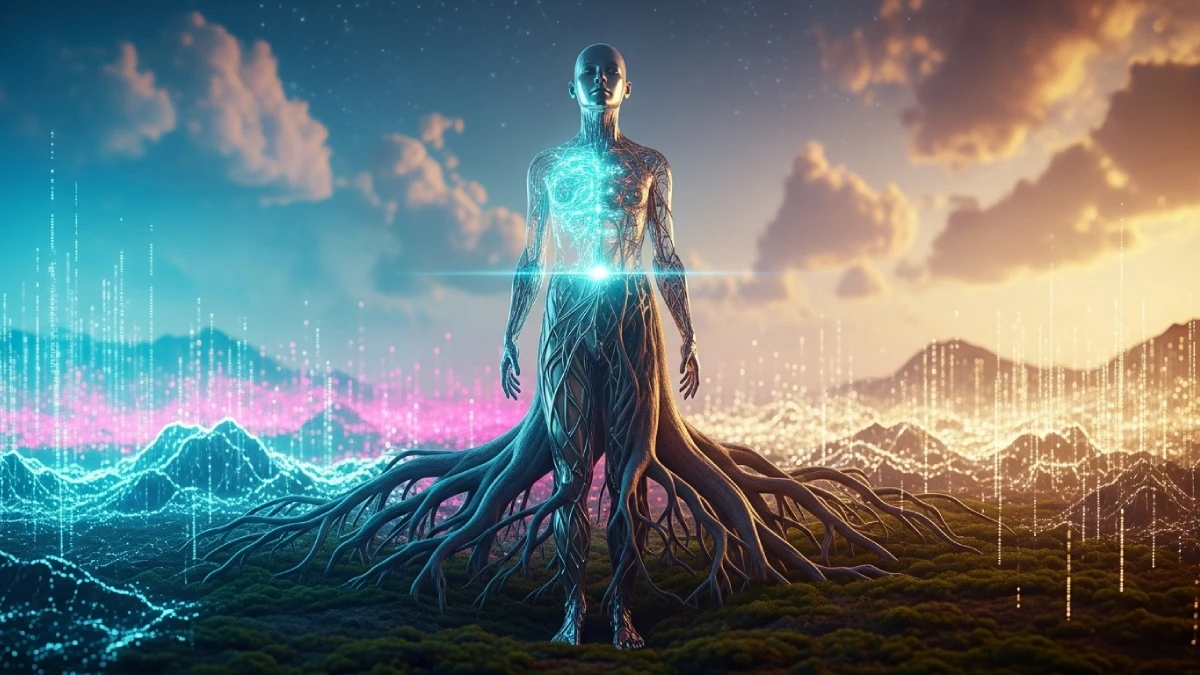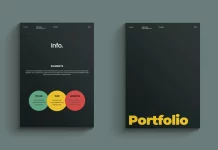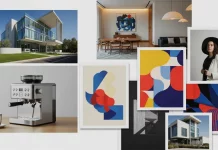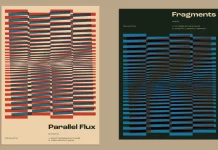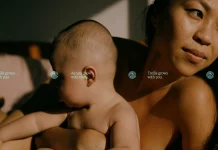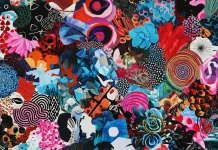Let’s Talk About Why Posthuman Aesthetics Matters Now.
Around the turn of the millennium, advances in biotechnology, artificial intelligence, and climate science began to undermine familiar ideas of the human. Bioengineers can now edit genes, create synthetic organs, and even plan babies with multiple parents. Information technologies allow people to control robotic limbs with their thoughts and interact through digital avatars. These interventions challenge long‑standing notions of a stable, universal human body and a clear division between natural and artificial. At the same time, ecological crises remind us that human life is entangled with non-human systems; we can no longer pretend to stand outside of nature. Traditional aesthetics, centered on the human subject, seems inadequate in this context. Posthuman aesthetics – the subject of this article – responds by decentring the human and inviting us to rethink art, design, and perception in a world where human and non‑human factors intermingle.
This piece offers an accessible yet rigorous introduction to posthuman aesthetics. It explains what the term means, why it is timely, and how it manifests across disciplines. The article draws on scholarly sources, such as Michael Steinmann’s definition of posthuman aesthetics as the radical decentring of the human and the blurring of dichotomies between natural and artificial, and on the Aarhus University research project, which frames posthuman aesthetics as a response to biotechnology and culture. It also includes examples from film and painting and reflects on broader cultural implications. Throughout, the tone is conversational and critical, inviting readers to engage with ideas that might reshape contemporary art and design.
What Is Posthuman Aesthetics?
Decentring the Human
In classical aesthetics, the human subject is the measure of beauty and the locus of meaning. Posthuman aesthetics challenges this central position. Philosopher Michael Steinmann notes that a posthuman aesthetic must “achieve a profound and radical de-centering of the human”. Instead of celebrating human abilities or moral virtues, posthuman aesthetics draws attention to what is other than the human – the animal, the technological, the material, and the ecological. According to the Aarhus University project outline, advances in biotechnology and information science “radically transgress” our notion of a shared human identity. Posthuman aesthetics, therefore, seeks to represent hybrid bodies and transhuman experiences in art and media.
Steinmann further explains that posthuman aesthetics blurs traditional dichotomies: natural/artificial, human/non‑human, subject/object, and creation/discovery. This blurring is not merely theoretical. In practice, it means that artworks may be co‑produced by humans and machines, incorporate living tissues and technologies, or present landscapes where boundaries between organic and synthetic are indistinguishable. Koyaanisqatsi, the 1983 film by Godfrey Reggio, offers an example. Its mechanical time‑lapse cinematography provides a non‑human “mechanical stare” that disrupts default human perception. The film equates the movement of cars and humans with the motion of clouds and tides, refusing to privilege the human. This perspective invites viewers to question anthropocentric assumptions about what is natural and what is cultural.
Hybrid Bodies and Relationality
Another core element of posthuman aesthetics is the celebration of hybrid bodies. Antonio Strati’s recent entry on posthumanist aesthetics emphasizes the “bodily predisposition to hybridization with other corporealities – nonhuman animals, plant life, and the sociomateriality of organizational artifacts”. Posthuman aesthetics highlights metamorphosis and the way human flesh becomes porous to technological and ecological influences. As a result, aesthetic judgment no longer concerns pure, ideal forms but focuses on the sensorial and experiential interactions between different entities.
Relationality is central to this vision. In her essay on posthumanist painting, Maegan Harbridge writes that form should be understood relationally rather than as a fixed object. A line becomes “the touching point of autonomous bodies” and offers “an undoing of the human”. She imagines abstract painting as a technology that trains perception to see relationships between human and non‑human bodies. Moreover, her method of “care/full looking” positions painting as an ethical practice that acknowledges the entangled nature of bodies and cultivates empathy for the more‑than‑human world. Posthuman aesthetics thus encourages viewers to perceive artworks as fields of relations rather than isolated objects.
A Positive Conception of the Posthuman
Critics sometimes fear that posthuman aesthetics will fetishize technology and erode human values. Steinmann warns against interpreting machines as extensions of human power and domination, which would be “all too human”. Instead, he argues that posthuman aesthetics must develop its own positive conception of the human – not by eliminating humanity, but by redefining it through encounters with the animal, the angelic, and the demonic. In Nietzsche’s Thus Spoke Zarathustra, he sees three figures that point beyond the conventional human: the animal represents our similarity and difference from other creatures, the angelic transcends ordinary experience with joy, and the demonic signals transgressive and unsettling energies. Posthuman aesthetics explores these figures and challenges artists and viewers to imagine new ways of being human.
Why Posthuman Aesthetics Resonates Today
Addressing Biotechnological and Environmental Challenges
Contemporary art and design occur amid rapid technological change and ecological crisis. The Aarhus University project notes that biotechnological interventions such as cloned organs and brain‑controlled prostheses increasingly challenge what it means to be human. Many public debates still treat these technologies as medical aids aimed at restoring normality. Posthuman aesthetics invites us to consider whether they instead usher in a “radically transgressed” notion of identity. When artists incorporate genetic manipulation, cyborg performance, or synthetic biology into their work, they encourage viewers to contemplate the moral and aesthetic implications of these innovations. Such practices can highlight both possibilities and dangers, prompting reflection on our responsibilities towards future beings.
Environmental degradation and climate change also demand new aesthetic sensibilities. Koyaanisqatsi’s mechanical gaze makes everyday human activities appear mechanical and regulated, revealing an imbalance not only between work and leisure but between human life and ecological systems. The film’s Hopi title translates to “crazy life” or “life out of balance,” urging viewers to seek another way of living. Contemporary eco‑art similarly uses time‑lapse, drone footage, and other non‑human perspectives to expose the impact of human activity on the Earth. Posthuman aesthetics thus aligns with ecological thinking by destabilizing anthropocentric viewpoints and fostering empathy with non‑human agents.
Challenging Humanist Art Histories
Posthuman aesthetics also responds to the limitations of humanist art histories. Traditional Western art often celebrates the idealized human figure, as exemplified by the Vitruvian Man. Posthumanist aesthetics diverges from these canons by emphasizing the “magmatic nature” of corporeality. The flesh is no longer a pure form but a site of metamorphosis open to contamination. In painting, Harbridge’s care/full looking resists modernist purity and embraces contamination and heterogeneous forces. Similarly, posthuman architecture experiments with biomimetic forms, responsive materials, and generative design, moving away from rigid, anthropocentric geometries towards dynamic, interdependent structures.
Moreover, posthuman aesthetics questions subject/object dualism. In the film Koyaanisqatsi, the camera treats human crowds, cars, clouds, and rivers with equal attention. This equality dissolves the hierarchy that privileges human subjects over their environment. In digital and interactive art, the viewer becomes part of the artwork through sensors and feedback loops, dissolving the boundary between observer and object. Such experiences illustrate the posthuman aesthetic goal of dissolving fixed boundaries and creating new modes of relation.
Inspiring Ethical Reflection
Posthuman aesthetics is not just a visual style; it carries ethical implications. Harbridge’s concept of care/full looking frames art as a practice of “radical care” that can dismantle normative conceptions of bodies and encourage more empathetic interactions. Koyaanisqatsi’s non‑human gaze invites viewers to abandon the “taken‑for‑granted human experience” and question militarized and mechanized visions of society. Strati argues that posthuman aesthetics can inspire organizational scholars to rethink innovation and management by recognizing the hybridization of human bodies with technologies. By emphasizing relationality and interdependence, posthuman aesthetics fosters an ethic of entanglement that can inform debates on bioethics, environmental policy, and social justice.
How Posthuman Aesthetics Manifests Across Fields
Visual Arts and New Media
In the visual arts, posthuman aesthetics often materializes through collaborations between artists, scientists, and machines. Bioartists use living tissues and genetic engineering to create sculptures and installations that challenge viewers’ perceptions of life. For example, tissue‑culture artworks fuse plant and animal cells, blurring species boundaries and inviting contemplation of hybridity. Digital artists employ algorithms, artificial intelligence, and generative systems to co‑create images, ceding some control to non‑human agents. This process aligns with the posthuman aesthetic aim of disrupting the binary between creator and created. VR and AR installations immerse participants in environments where their movements alter the artwork, dissolving the spectator/object distinction.
Film and video provide fertile ground for posthuman aesthetics. Koyaanisqatsi’s mechanical stare is a classic example, but many contemporary films continue this exploration. Drone cinematography offers perspectives unavailable to human eyes and reveals patterns in landscapes and cities. Time‑slice and microscopic photography expose processes such as plant growth or cellular activity, reminding viewers of the temporal scales beyond human perception. In such works, the camera becomes a tool for critical perception, exposing hidden relations and decentring the human.
Architecture and Design
Posthuman aesthetics influences architecture and design by encouraging practitioners to consider the agency of materials, environments, and non‑human users. Architects inspired by posthuman theory design buildings that adapt to climatic changes, incorporate living organisms, or respond to occupants’ physiological signals. These structures blur the distinction between building and body, interior and exterior, human and environment. For example, responsive façades adjust to sun and wind patterns, while biocentric designs integrate habitats for birds and insects. Such projects move beyond human-centered utility and reflect a more expansive understanding of life.
In product and industrial design, posthuman aesthetics invites designers to embrace irregularity, interactivity, and sustainability. Instead of sleek, ideal forms, products might evolve over time, incorporate recycled materials, or function symbiotically with natural systems. Designers may collaborate with algorithms or AI to generate forms that challenge human imagination. This approach not only produces novel aesthetics but also questions ownership, authorship, and consumption.
Literature and Critical Theory
Posthuman aesthetics extends into literature and philosophy. Writers explore narratives from non‑human perspectives, such as animals, plants, AI, or geological formations. These stories reimagine consciousness and agency, inviting readers to empathize with more‑than‑human entities. The Aarhus project identifies “the convergence of biological and cultural evolution” as a key theme. In fiction, this convergence appears in works that depict co‑evolutionary relationships between humans and machines or portray posthuman societies where species boundaries have dissolved. Critical theorists like Rosi Braidotti, Karen Barad, and Cary Wolfe examine how language, power, and knowledge must adapt to a posthuman condition. Their insights inform artistic practices and encourage a pluralistic, non‑hierarchical approach to aesthetics.
Practical Insights for Artists and Designers
Embrace Collaboration With Non‑Human Agents
To engage with posthuman aesthetics, creators should consider collaborating with non‑human agents – whether biological organisms, algorithms, or environmental forces. For painters, this might mean allowing materials to flow, crackle, or erode in ways that transcend control. For filmmakers, it involves experimenting with non‑human cameras, sensors, and data‑visualization techniques to reveal unseen patterns. Designers might program generative software to co‑create forms or work with living materials that grow and change. Through such collaborations, creators experience new forms of agency and relinquish the notion of sole authorship.
Cultivate Care and Ethical Awareness
Posthuman aesthetics is grounded in an ethic of care. Harbridge’s practice of care/full looking serves as a model: she uses painting to attend to the relational qualities of form and to “become oddkin with the animate materiality of edges, colors and shadows”. Designers and artists can adopt similar mindfulness by considering the environmental and social impacts of their materials and processes. They can also engage audiences in reflective experiences that encourage empathy across species and systems. By foregrounding care and relationality, creators contribute to a cultural shift towards more sustainable and inclusive practices.
Explore Alternative Temporalities and Perceptions
Human perception operates within limited temporal and spatial scales. Posthuman aesthetics invites creators to expand these scales. Time‑lapse, slow motion, magnification, and microscopic imaging are techniques that reveal processes beyond ordinary perception. In architecture, designers might incorporate elements that change over seasons or decades, highlighting the building’s life cycle. In literature, authors can experiment with non‑linear narratives that mirror ecological cycles or networked consciousness. These strategies help audiences appreciate the interconnectedness of beings and events and challenge anthropocentric conceptions of time and space.
Personal Reflections: A Designer’s Perspective
As a design critic and editor, I find posthuman aesthetics both inspiring and unsettling. On one hand, it opens vibrant possibilities. The idea that art and design can involve plants, algorithms, or cosmic forces feels liberating. It encourages us to think beyond the human and to imagine new alliances between species and systems. On the other hand, posthuman aesthetics demands humility. It asks us to relinquish some control and to acknowledge that our bodies, technologies, and environments are intertwined. That awareness can be uncomfortable, especially for creatives trained to assert personal style and mastery.
Nevertheless, the current era demands such discomfort. Climate change, AI ethics, and biotechnology all force us to confront our limitations. Posthuman aesthetics offers tools to navigate this terrain. It teaches us to see ourselves as part of a larger network of relations, to value hybrid bodies, and to question rigid categories. By embracing these lessons, artists and designers can produce work that resonates with contemporary concerns and shapes a more compassionate, interconnected future.
Conclusion
Posthuman aesthetics is not a passing trend. It arises from profound changes in technology, ecology, and culture. By decentring the human and emphasizing relationality, it provides a framework for rethinking art, design, and perception. Scholars like Michael Steinmann and Antonio Strati highlight its philosophical foundations, while projects such as Aarhus University’s Posthuman Aesthetics explore its application in art and literature. Films like Koyaanisqatsi and essays on posthumanist painting demonstrate how non‑human perspectives can disrupt familiar modes of seeing and inspire ethical reflection.
The future of posthuman aesthetics will likely involve deeper collaborations with AI, biotechnology, and ecological systems. It will challenge artists, designers, and audiences to consider their relationship with the non‑human and to cultivate practices of care and reflection. By engaging with these ideas now, we can foster creative approaches that are both intellectually rigorous and emotionally resonant. Such engagement not only enhances artistic practice but also contributes to a broader cultural shift towards a more inclusive, sustainable, and compassionate world.
If you want to learn more about Posthuman Aesthetics, we recommend this paper on ResearchGate by Antonio Strati of University of Trento. Browse WE AND THE COLOR’s AI, Art, and Design sections for more.
Subscribe to our newsletter!

